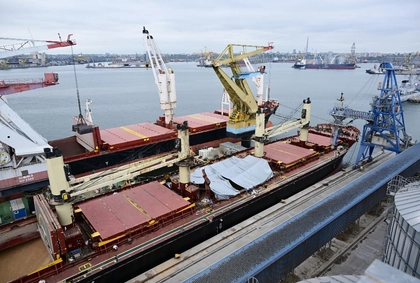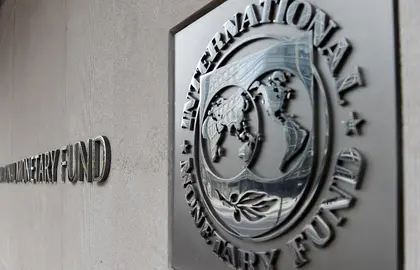Ukraine is a month away from its deadline to negotiate a new agreement with Eurobond holders. The standstill finishes during the first half of August, following two years of an agreed absence of payments.
Ukraine informed its creditors that it would be unable to pay following Russia’s full-scale invasion in February 2022, requesting new conditions of payments. For almost four months, Ukraine has been preparing for these negotiations, and for the last two years, the Ministry of Finance has been keeping in touch with its creditors.
JOIN US ON TELEGRAM
Follow our coverage of the war on the @Kyivpost_official.
The Ukrainian government took part in debt restructuring negotiations with Eurobond holders over a period of 12 days between June 3-14. News emanating from the first round of negotiations brought little hope, with the government failing to reach a compromise. Bondholders did not agree with a nominal cut of up to 60 percent, proposed by Ukraine's Ministry of Finance.
The government has little room to offer more to bondholders, otherwise International Monetary Fund (IMF) debt sustainability targets risk not being reached.
The Economist wrote an article that Ukraine might find itself in default if negotiations do not end with an agreement.
But even in the case of default, Ukraine will continue negotiating. It is pressed between agreements with the IMF on one side, and its own will to regain access to markets in the future.
Here are five important things to help explain Ukraine’s debt restructuring negotiations.

EBRD, Aon Launch War Risk Insurance to Cover Ukraine’s Domestic Cargo
- Ukraine is not seeking restructuring because of ineffective policy – the country has spent all its pre-war budget due to Russia’s invasion.
A month ago, Ghana agreed a sovereign debt restructuring deal, emerging from a default declared in January 2023. Its economy was dealt a blow when inflation reached double digits and prices on oil – one of Ghana’s key exports – fell.
Before the COVID-19 pandemic, Ghana had a budget deficit of 7.5 percent of GDP. That doubled to 15.3 percent. The cause was high expenditure and low state incomes, Oleksandr Parashchii, head of research at Concorde Capital, told Kyiv Post.
“They have increased debt rapidly: 61 percent of GDP in 2019, 80 percent in 2021, 93 percent in 2022. The same is true for interest payments”, Parashchii said.
Between 2020 and 2021, Ghana spent half of the country’s revenues on interest payments. “They had a painful debt restructuring of both internal and external debt, the latter also undertaken with IMF assistance. Deal broken and no panic,” Parashchii added.
But Ukraine has different reasons for its increasing debt – Russia’s unprovoked full-scale invasion of the country.
Prior to that, Ukraine’s president signed a planned 2021 state budget expenditure of Hr. 1.3 trillion ($46 billion). Ukraine’s planned expenditure for 2024 more than doubled and reached Hr. 3.3 trillion ($914 billion).
Defense expenditure has increased from 5 percent of GDP to 22 percent of GDP. For 2024, Ukraine plans to spend more than the whole civilian 2021 budget – Hr. 1.7 trillion ($47 billion).
But that’s not the end of the story. The Ministry of Finance will now seek sources to pay an extra Hr. 500 billion ($12.5 billion) of war expenditure in 2024.
Due to a half-a-year delay of $60 billion in military and financial aid from the US, Ukraine had to purchase weapons the country expected to get for free.
This resulted in reallocating expenditure planned for the second half of 2024 to the beginning of the year. The West does not allow financial aid to be spent for military purposes, so Ukraine relies on its own wallet to buy weapons and ammunition.
Now the situation is such that money for the remainder of 2024 must be found – Ukraine is planning to raise a number of taxes this year, but specific estimates are not public at the time of writing.
- Ukraine is one or two steps away from a default rating, but the country has been there before and successfully bounced back.
Ukraine’s internal money is spent mostly on the war with Russia, meaning a standstill with creditors has been a necessary action to readdress financial resources. The war has turned out to be prolonged, exhausting, and costly.
Standard & Poor's Global Ratings downgraded Ukraine’s Foreign Currency LT credit rating to "CC" with a negative outlook in March 2024. In June 2024, Fitch Group affirmed Ukraine's Long-Term Foreign Currency Issuer Default Rating at 'CC', Moody’s – Ca with a negative outlook.
All three ratings are one or two steps below default credit rating scores.
One scenario that could lead to a default rating is that Ukraine’s borrowing position reaches a point that private creditors are not willing to provide the country with lending.
The lending deals Ukraine has been signing since 2022 have been with international financial institutions, since private lenders see no meaningful return from Ukraine during wartime.
“The Economist thinks we will get out of this state only after Russia’s full-scale invasion is over. But we may get out of it earlier when the war cools down. This already happened [between] 2014-2022”, Parashchii wrote in a Facebook post.
Indeed, after previous debt restructuring in 2015, Ukraine’s credit rating was upgraded to S&P’s “B” and Moody’s’ “Caa1”.
In 2017, Ukraine issued Eurobonds for the first time after 2015 debt restructuring negotiations ended. The country reached stability following the turmoil of Euromaidan and the start of Russia’s invasion of the Donbas region through its proxies.
Back then, Ukraine wanted to regain access to Western capital markets. And it did, issuing Eurobonds between 2018 and 2021. Now the Ministry of Finance is intending to repeat history.
- Ukraine is willing to repay the interest – it is crucial to leave room for return in the capital markets.
Ukraine understands its financial liabilities. “We remain fully committed to continuing our constructive engagements to resolve the outstanding differences,” Sergii Marchenko, Ukraine’s finance minister, said in a press release.
In the government’s proposal, Ukraine is still committed to paying interest of one percent in the second quarter of 2024 and throughout 2025; three percent during 2026-2027; and six percent from 2028 to maturity.
This did not coincide with what bondholders wanted – a 7.75 percent cash coupon and 0.5 percent as paid-in-kind (PIK) over the 2024-2027 period.
The final decision will come after a new round of negotiations.
- It is organic for creditors to want profit, but no one chose the full-scale invasion scenario.
Ukraine and the West wanted to win against Russia fast. But Russia learned how to evade EU sanctions through third countries, a shadow fleet, and cooperation with China, leaving enough cashflow for its war.
Ukraine will not give up fighting since it has already witnessed the effects of being under Russia’s control, during the times of the Russian empire and the Soviet Union. Both eras ended with Ukraine’s economic stagnation, repression, banning of Ukrainian culture and language, as well as the death of the country’s aristocracy.
This is the reason why Ukrainians do not want to give in to Russia even after two and a half years of an exhausting war.
- Default in any country does not automatically mean an economic crisis.
A default rating will inevitably be imposed upon Ukraine since it happens every time Ukraine renegotiates new debt servicing terms with creditors. This is a judicial procedure.
Credit rating agencies usually downgrade debt securities to “restricted default” or “selective default” in this situation.
The word “default” might spark anxiety among Ukrainians. It wakes up an old trauma of a 1998 crisis in Russia. At the time, oil prices plunged to $10 per barrel, and Russian Eurobonds became extremely expensive – the country had to pay a 200 percent interest rate.
“The government did not want to borrow at 200 percent, so it decided to go into default. International creditors saw the situation but did not want to lend either. The ruble had to be depreciated. Their central bank reserves were less than $15 billion and the ruble plummeted.
As a point of comparison, Ukraine now has $39 billion central bank reserves”, Parashchii told Kyiv Post.
Ukraine now has the resources to keep the dollar-hryvnia rate at a decent level. It does not rely on private creditor financing since it is now financed directly from other countries and International financial institutions “on preferential terms”, Parashchii said.
“Besides, Ukraine’s interest rates on government bonds are significantly lower than 200 percent so we do not have a government bond pyramid,” he added.
You can also highlight the text and press Ctrl + Enter






